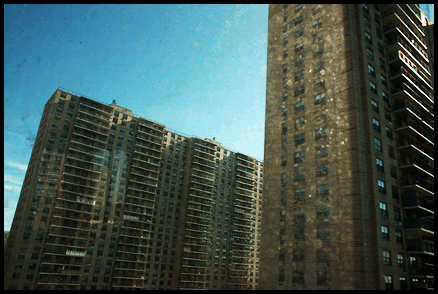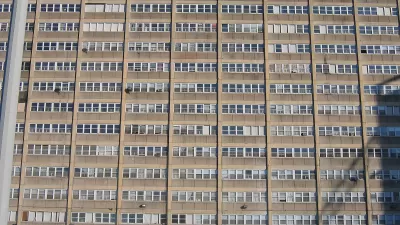A new study shows that kids living in subsidized housing in New York do significantly worse on standardized tests than those outside the system. Is it possible to understand the true cause of the problem, and if we do, how do we fix it? Judy Chang reports.
What is the best way to house those with the nation's lowest incomes? That's a question that is difficult to answer, in theory and in practice. For decades, public housing has been notoriously underfunded and often poorly maintained -- an experiment with good intentions but few success stories.
A new study offers more grim news regarding the state of public housing. Kids who live in projects subsidized by the New York City Housing Authority are doing significantly worse on standardized tests than their non-publicly housed counterparts, according to a report from the Furman Center for Real Estate and Urban Policy and the Institute for Education and Social Policy, both at New York University.

The study supports the general thinking that public housing "creates unhealthy environments for its tenants," according to the report. Furman Center Director Vicki Been says that by comparing students who live in public housing against those who don't, it is one of very few pieces of research that specifically examines the well-being of public housing tenants -- and probably the first to establish the housing-education link.
Using the most recent data available from the city, the authors of the study found that from elementary grades through high school, an indisputable gap exists in student performance -- even when controlling for factors like race and sex, and even when students attend the same school. About half of elementary students who don't live in public housing units pass their reading and math exams; for those who are publicly housed, the figure hovers around the high 30s and low 40s, respectively.
High schoolers are doing better, although not by much. The passing rate of non-public housing students for math and English tests is higher, at 60% and 75% respectively, while NYCHA students pass at a rate of about 53% and 70%.
Social Capital
Pinpointing the root of the problem is difficult. The child's environment, financial disadvantage, overcrowding, and concentrated poverty have all been cited as factors. "In this country, public housing has been so stigmatized," said Anastasia Loukaitou-Sideris, a professor of urban planning at the University of California, Los Angeles.
The Furman study argues that the child's environment is a significant factor -- not just the housing complex itself, but their neighborhood and school. The schools themselves are relatively low-performing, and the teachers who teach in them also have slightly less education and experience than their peers. So how do you account for the disparity between the publicly-housed students and their immediate peers in the same schools?
The difference lies in the double-whammy of poverty and lack of education at home. The numbers show that where there are high concentrations of poverty, there are single moms, probably on welfare. All too often, their school-aged children lack role models who are educated themselves, says Loukaitou-Sideris. "It's easy for [the kids] to drop out of school sometimes, there's not much support. They don't have the support of their immediate family or the wider community. That social capital is missing."
We're a long ways from the community-driven public housing spearheaded by Jane Addams of the 1920s. People who can get out of public housing are not much better off than the ones who stay behind, although the ones who do certainly need the most help, Loukaitou-Sideris continues. "It seems like we have abandoned people who need education the most."
Improving Conditions At Home
As it is, much of the attention placed on public housing has emphasized strategies to get people out of it, and fewer on how to better the lives of those in it. The Furman-IESP study is one of a very few on the population that is publicly housed.
Been and her colleagues are ready to take on a new study that hones in on lottery-style apartment placements (which is, conveniently, as random a sample as researchers can ask for). In New York City, some families who "win" end up in housing units that are part of mixed-income, inclusionary zoned buildings. "We're going to follow the ones who get better housing and win the lottery, and those who don't and look at how these kids of these families do. And that will tell us the role of housing," said Been.
More importantly, the study provides hard evidence that New York and other major cities with public housing woes need to justify action. Though Been and her colleagues don't know the answers yet, they urge city officials to work together on this. "They need to coordinate and think strategically about the needs of this population," she says.

Planetizen Federal Action Tracker
A weekly monitor of how Trump’s orders and actions are impacting planners and planning in America.

Map: Where Senate Republicans Want to Sell Your Public Lands
For public land advocates, the Senate Republicans’ proposal to sell millions of acres of public land in the West is “the biggest fight of their careers.”

Restaurant Patios Were a Pandemic Win — Why Were They so Hard to Keep?
Social distancing requirements and changes in travel patterns prompted cities to pilot new uses for street and sidewalk space. Then it got complicated.

Platform Pilsner: Vancouver Transit Agency Releases... a Beer?
TransLink will receive a portion of every sale of the four-pack.

Toronto Weighs Cheaper Transit, Parking Hikes for Major Events
Special event rates would take effect during large festivals, sports games and concerts to ‘discourage driving, manage congestion and free up space for transit.”

Berlin to Consider Car-Free Zone Larger Than Manhattan
The area bound by the 22-mile Ringbahn would still allow 12 uses of a private automobile per year per person, and several other exemptions.
Urban Design for Planners 1: Software Tools
This six-course series explores essential urban design concepts using open source software and equips planners with the tools they need to participate fully in the urban design process.
Planning for Universal Design
Learn the tools for implementing Universal Design in planning regulations.
Heyer Gruel & Associates PA
JM Goldson LLC
Custer County Colorado
City of Camden Redevelopment Agency
City of Astoria
Transportation Research & Education Center (TREC) at Portland State University
Camden Redevelopment Agency
City of Claremont
Municipality of Princeton (NJ)



























